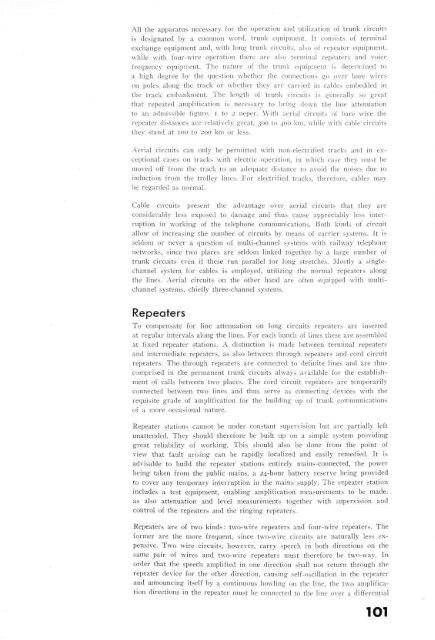contents - History of Ericsson - History of Ericsson
contents - History of Ericsson - History of Ericsson
contents - History of Ericsson - History of Ericsson
Create successful ePaper yourself
Turn your PDF publications into a flip-book with our unique Google optimized e-Paper software.
All the apparatus necessary for the operation and utilization <strong>of</strong> trunk circuits<br />
is designated by a common word, trunk equipment. It consists <strong>of</strong> terminal<br />
exchange equipment and, with long trunk circuits, also <strong>of</strong> repeater equipment,<br />
while with four-wire operation there are also terminal repeaters and voice<br />
frequency equipment. The nature <strong>of</strong> the trunk equipment is determined to<br />
a high degree by the question whether the connections go over bare wires<br />
on poles along the track or whether they are carried in cables embedded in<br />
the track embankment. The length <strong>of</strong> trunk circuits is generally so great<br />
that repeated amplification is necessary to bring down the line attenuation<br />
to an admissible figure, i to 2 neper. With aerial circuits <strong>of</strong> bare wire the<br />
repeater distances are relatively great, 300 to 400 km, while with cable circuits<br />
they stand at 100 to 200 km or less.<br />
Aerial circuits can only be permitted with non-electrified tracks and in exceptional<br />
cases on tracks with electric operation, in which case they must be<br />
moved <strong>of</strong>f from the track to an adequate distance to avoid the noises due to<br />
induction from the trolley lines. For electrified tracks, therefore, cables may<br />
be regarded as normal.<br />
Cable circuits present the advantage over aerial circuits that they are<br />
considerably less exposed to damage and thus cause appreciably less interruption<br />
in working <strong>of</strong> the telephone communications. Both kinds <strong>of</strong> circuit<br />
allow <strong>of</strong> increasing the number <strong>of</strong> circuits by means <strong>of</strong> carrier systems. It is<br />
seldom or never a question <strong>of</strong> multi-channel systems with railway telephone<br />
networks, since two places are seldom linked together by a large number <strong>of</strong><br />
trunk circuits even if these run parallel for long stretches. Mostly a singlechannel<br />
system for cables is employed, utilizing the normal repeaters along<br />
the lines. Aerial circuits on the other hand are <strong>of</strong>ten equipped with multichannel<br />
systems, chiefly three-channel systems.<br />
Repeaters<br />
To compensate for line attenuation on long circuits repeaters are inserted<br />
at regular intervals along the lines. For each bunch <strong>of</strong> lines these are assembled<br />
at fixed repeater stations. A distinction is made between terminal repeaters<br />
and intermediate repeaters, as also between through repeaters and cord circuit<br />
repeaters. The through repeaters are connected to definite lines and are thus<br />
comprised in the permanent trunk circuits always available for the establishment<br />
<strong>of</strong> calls between two places. The cord circuit repeaters are temporarily<br />
connected between two lines and thus serve as connecting devices with the<br />
requisite grade <strong>of</strong> amplification for the building up <strong>of</strong> trunk communications<br />
<strong>of</strong> a more occasional nature.<br />
Repeater stations cannot be under constant supervision but are partially left<br />
unattended. They should therefore be built up on a simple system providing<br />
great reliability <strong>of</strong> working. This should also be done from the point <strong>of</strong><br />
view that fault arising can be rapidly localized and easily remedied. It is<br />
advisable to build the repeater stations entirely mains-connected, the power<br />
being taken from the public mains, a 24-hour battery reserve being provided<br />
to cover any temporary interruption in the mains supply. The repeater station<br />
includes a test equipment, enabling amplification measurements to be made,<br />
as also attenuation and level measurements together with supervision and<br />
control <strong>of</strong> the repeaters and the ringing repeaters.<br />
Repeaters are <strong>of</strong> two kinds: two-wire repeaters and four-wire repeaters. The<br />
former are the more frequent, since two-wire circuits are naturally less expensive.<br />
Two wire circuits, however, carry speech in both directions on the<br />
same pair <strong>of</strong> wires and two-wire repeaters must therefore be two-way. In<br />
order that the speech amplified in one direction shall not return through the<br />
repeater device for the other direction, causing self-oscillation in the repeater<br />
and announcing itself by a continuous howling on the line, the two amplification<br />
directions in the repeater must be connected to the line over a differential<br />
101
















